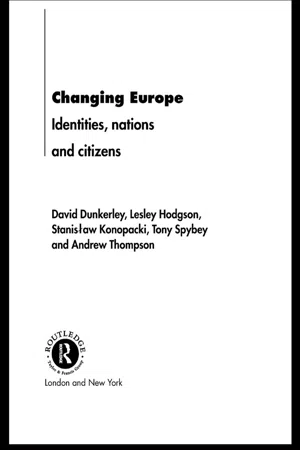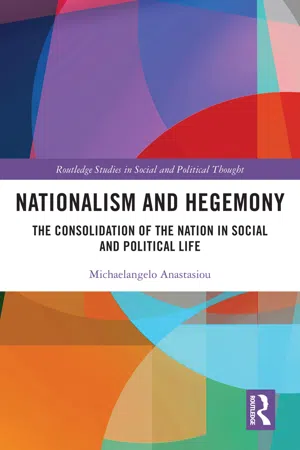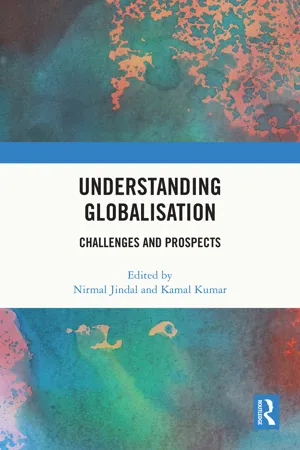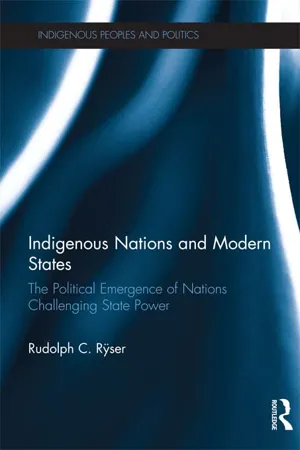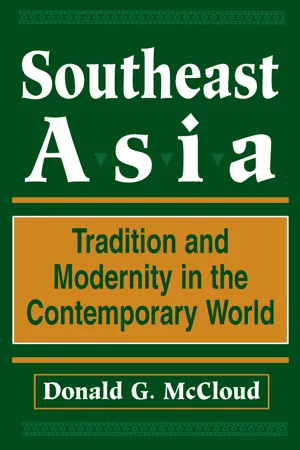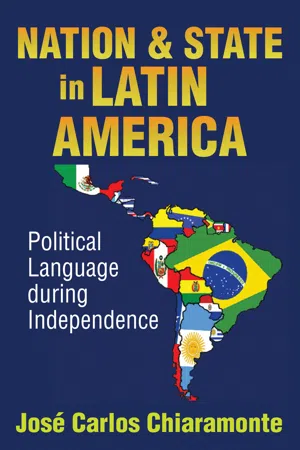History
Emergence of Nation States
The emergence of nation states refers to the process by which independent, unified political entities formed from smaller, fragmented territories. This development was marked by the rise of centralized governments, shared cultural identities, and defined borders. It played a significant role in shaping modern geopolitics and international relations.
Written by Perlego with AI-assistance
Related key terms
7 Key excerpts on "Emergence of Nation States"
- eBook - ePub
Changing Europe
Identities, Nations and Citizens
- David Dunkerley, Lesley Hodgson, Stanislaw Konopacki, Tony Spybey, Andrew Thompson(Authors)
- 2003(Publication Date)
- Routledge(Publisher)
The situation in the Balkans indicates that the ideal of the nation-state is one which many groups still consider to be worth fighting for. Elsewhere, numerous movements seek independent nation-states, while national governments continue to speak on behalf of ‘the nation’. Thus the idea of the nation-state arguably remains as appealing as it was two centuries ago. It is nevertheless becoming more difficult now for states to pursue the ideal of the cultural nation as they once did. In western Europe governments have increasingly promoted a civic version of the nation-state, in which citizens hold multiple identities; identifying, for example, with their ethnic group, their nation and/or with the wider polity of which they are citizens. This version of the nation-state has become a necessity in countries that have experienced considerable immigration, as well as perhaps increased demands for autonomy from ethnic and national minorities. In these cases governments have had to search for new ways of maintaining the unity of the nation-state. As we will see, however, in other countries the state has become firmly aligned with one ethnic group. For us, the important questions are whether we will see a movement away from the ethnic nation-state in Europe, and, if so, how will ‘the nation’ be defined in this context? Before considering the current and future prospects of the idea of the nation-state, we must understand the routes this idea has taken.The rise and transformation of the nation-state: 1700s to 1945Searching for the origins of the nation-state is something of a red herring; since pure nation-states do not exist, as noted above, it is not possible to identify when they came into being. As we have said, however, the idea of the nation-state has been enormously powerful in European political history, as governments and political movements have sought to convert the theory into practice. What we need to consider, then, is the nation-state as a process, rather than as an entity. We will therefore focus on three processes: the development of the national territory; the transformation of the state; and the building of popular identification with nation and state.Dimensions of change
With regard to territory there are two points we should make. The first is that it is broadly acknowledged that the significance of national frontiers has developed gradually, since the 1648 Treaty of Westphalia. This Treaty ended the Thirty Years’ Wars that had raged across much of Europe. Among the consequences of the Treaty, arguably the most significant was that it established the principle of sovereignty, thus recognising that sovereigns were the sole source of power within their territory and the representative of that territory in foreign affairs.The second point is that since this period the state has come to increasingly occupy the entire national territory. Until the late eighteenth century, and more particularly the latter part of the nineteenth century, the state made little impact on the mass of the population throughout the national territory. Navari (1981) argues that until the French Revolution monarchs made little attempt to effect centralisation throughout their realm. Indeed, she suggests, if they had it is very likely that various interested parties would have resisted such moves. Significant changes began to happen from the late eighteenth century onwards. The cumulative effect of change in post-Westphalian Europe was that the state increasingly came to occupy and, indeed, create - eBook - ePub
Nationalism and Hegemony
The Consolidation of the Nation in Social and Political Life
- Michaelangelo Anastasiou(Author)
- 2022(Publication Date)
- Routledge(Publisher)
9 The Emergence of Nations
DOI: 10.4324/9781003172659-9A long-standing and unresolved issue with regard to historical analyses of nations concerns the various assumptions that penetrate the field of analysis (Mann, 2009, pp. 3–4; Reynolds, 1997, Chapter 8 ; Smith, 1998, Chapters 1 and 8 ). One should consider, for instance, that most historical accounts of nations were written after the consolidation of nations and the generalization of nationalist ideology. Ergo, historical analyses of nations are often conducted through the lens of nationalist ideology, where nations are assumed to be perennial and politically “awakened” during the nineteenth and twentieth centuries (Reynolds, 1997, pp. 252–253; Smith, 1998, p. 18). As noted in earlier chapters, perennialist understandings of nations were contested on the basis of empirical evidence, which demonstrated that nations emerged and came to be consolidated in modern times. However, certain presuppositions that guided perennialist understandings of nations, namely the presumption of unitary nations, have penetrated even modernist accounts of nations. Modernists, as an example, very often understand the emergence and consolidation of nations as a process of cultural homogenization that undermined local particularisms (Anderson, 2006; Brass, 1991; Gellner, 1983; Giddens, 1985; Kedourie, 1961; Smith, 1986). But this assumption has been theoretically and empirically scrutinized by recent literature, which has emphasized the inherently “fragmented” character of nations, e.g. in terms of culture, class, gender, race, religion, ideology, etc.).The presumption of unitary nations is symptomatic of epistemological commitments and inherent limitations in historical analysis. In regard to the latter, one should note that historical analyses of nations are particularly challenging, in light of the fact that appropriate historical data are often absent and, when available, often unreliable. As Miroslav Hroch (1993), the notable historian of national movements, notes: “[E]very historian of national movements agrees there are numerous data gaps in our understanding of them. In this sense, all defensible conclusions still remain no more than partial findings, and all ‘theories’ should be taken as projects for further research” (p. 4). Eugen Weber similarly cautions against historical conjecture. In his historical survey of French linguistic diversity, as an example, he notes the following: - eBook - ePub
Understanding Globalisation
Challenges and Prospects
- Nirmal Jindal, Kamal Kumar(Authors)
- 2023(Publication Date)
- Routledge India(Publisher)
In the existing literature on State sovereignty, there is a universalist interpretation of State formation presupposing the Peace Treaty of Westphalia (1648), which is mainly a Eurocentric narrative. That narrative ignored the experiences and narratives of State formation in other parts of the world, primarily the developing south. Thus, the existing perception of the nation state and its sovereignty represents only one side of the story, as all of them are ontologically biased with the problem of ‘eurocentrism’. The omnipresence of modern nation states is being established through the following three critical incidents of modern history:- The Peace Treaty of Westphalia (1648) and the emergence of territorial rights,
- The emergence of the UN (1945) and the equal recognition of modern nation states globally,
- The process of decolonization and the rise in the number of nation states in the developing world.
(Behera 2020 , 143)Interestingly, the essential constituting elements of nation states have not been the same throughout history, particularly when considering cases of State formation in Asia, Africa, and Latin America. The global map is constantly changing; similarly, it is also true that the territorial configurations across the world are also evolving. For example, the boundaries of the Westphalian nation in the post–Cold War period are not the same as they were in 1648. Not only that but the issue of sovereignty, that is, exclusive rights of the nation states, has also been challenged by the global market forces and some common global dilemmas. Similarly, the State is also juggling non-traditional security threats such as pandemics and pollution with the question of human security. For this reason, the State cannot solely play the role of ‘net security provider’ to all its citizens.Moreover, the world’s major powers have also ignored the notion of sovereign equality and the principle of non-interference, especially in the internal matters of weaker nation states. Between 1990 and 2005, the fraction of unauthorized State interventions reached 425, compared to 690 cases of State interventions that occurred between 1946 and 1989 (Pickering and Emizet 2009 - eBook - ePub
Indigenous Nations and Modern States
The Political Emergence of Nations Challenging State Power
- Rudolph C. Ryser(Author)
- 2012(Publication Date)
- Routledge(Publisher)
The breakdown of empires in the 18th, 19th and 20th centuries saw the emergence of the modern state when three “self-created states” proclaimed their existence. The United States of America (1789) and the Republic of Haiti (1804) in the western hemisphere and the French Republic in 1792 started a two-century rush to form new states out of empires and the colonial hold of states like Germany, France, Spain, Portugal, England and the United States of America. From these beginnings, states formed throughout the world in regions where no indigenous history served as the basis for the formation of such states. Although some states were formed by nations, most nations fell under the control of colonizing states. States were “superimposed” on top of preexisting nations without their consent. Nations that would have been free in their own right found themselves under the control of rulers who exercised the centralized power of a state. Peeking from beneath the superimposed states smothering political dominance were thousands of bedrock nations that sought to exercise their right to self-determination and self-government. For many nations, controls presently imposed by modern states are often more onerous than earlier experiences with imperial authority. But the nations persist in their desire and intention to free themselves from external controls.The world’s Fourth World nations (5,000 to 9,000 different indigenous peoples, depending on your source) give clear testimony that, while human cultural diversity is seriously threatened, there is a stalwart and steady pushback against occupation by neighboring nations, empires or state governments. As in centuries past, nations are struggling in the modern era to reaffirm their distinct political identity and to resume their role as participants in international relations.In Chapters 3 and 4 - eBook - ePub
Human and Minority Rights Protection by Multiple Diversity Governance
History, Law, Ideology and Politics in European Perspective
- Joseph Marko, Sergiu Constantin(Authors)
- 2019(Publication Date)
- Routledge(Publisher)
section 2.2 ).Hence, the two processes of state formation and nation building are in empirical reality intimately interwoven, but must – for analytical purposes – be distinguished in order to be able to understand the transformation of social and political ordering from the medieval European political landscape referred to in the beginning to modern national states (see Max Weber’s definition in Chapter 2 , Box 2.2 ). This analytical distinction is necessary, because it is exactly the question and problem of the legal and empirical institutionalisation of the relationship between the concepts of state and nation and the different possible combinations which – defined as civic or ethnic model – determines the conceptual as well as the legal-institutional path-dependencies - eBook - ePub
Southeast Asia
Tradition And Modernity In The Contemporary World, Second Edition
- Donald G Mccloud(Author)
- 2018(Publication Date)
- Routledge(Publisher)
At the beginning of each cycle, political power and economic control were scattered among local, fortified towns and hamlets ruled by hereditary chieftains, recognized as individuals of prowess. Hermann Kulke has called this the nuclear area, whereas others have labeled it the substate or prestate level because of its limited territory, lack of bureaucratic structure, and dependence on the personality and ability of the particular leader. I refer to this early phase of state formation as the nascent state. The second phase began with the rise of a charismatic leader who, using military skill and a band of loyal followers, consolidated authority and built a centralized polity complete with capital, court, rudimentary administrative structures, and military forces. Kulke has labeled these early kingdoms, and most scholars agree that at this point the structure was sufficiently strong to be defined as a state, although its internal structures—such as bureaucracy and the military—remained poorly defined. At the peak, or third, level of the cycle was the imperial kingdom, which was differentiated from the early kingdom in several ways. First, it represented the forcible unification of two or more areas of formerly independent kingdoms. It relied on a centralized bureaucracy, and it maintained firm control over, and had legitimate access to, all of its regions - eBook - ePub
Nation and State in Latin America
Political Language During Independence
- Jose Carlos Chiaramonte(Author)
- 2017(Publication Date)
- Routledge(Publisher)
The first obstacle in this task is of course that old chestnut, the ‘dictionary': how to define State and other associated concepts such as nation, people or sovereignty. I would like to make it clear then that I will not be taking a specific definition of State as my starting point, but only a taking stock based on the properties generally attributed to it by historians who deal with the subject. 1 This is in part due to the well-known array of alternatives offered by the specialist literature regarding the nature of the term State. 2 We might, however, ask whether the confusion in the attempts to write the history of the Latin American States (generally, an account of political events attached to sociological explications) is not due to a lack of clear definition of the concept of State. The view I have taken here is that, while delving into the difficulties presented by the concept of State does makes our task easier, most of the pitfalls that complicate attempts to write a history of Latin American States stem nevertheless from widespread confusion about the period use -the Independence period- of nation and State, a confusion which arises to a large extent from confusion about the concept of nationality. The confusion is, in a nutshell, the result of assuming that most of today’s Latin American nations already existed from the early days of. Independence. 3 Although in recent historiography this view is being relinquished, its effects persist, hindering understanding of the nature of the sovereign political entities emerging in the process of the independences. This is visible in the neglect of issues like the emergence, in the early stages of the independences, of sovereign entities in the shape of cities or provinces, and their particular political practices
Index pages curate the most relevant extracts from our library of academic textbooks. They’ve been created using an in-house natural language model (NLM), each adding context and meaning to key research topics.
